Indexed In
- Open J Gate
- Academic Keys
- ResearchBible
- China National Knowledge Infrastructure (CNKI)
- Centre for Agriculture and Biosciences International (CABI)
- RefSeek
- Hamdard University
- EBSCO A-Z
- OCLC- WorldCat
- CABI full text
- Publons
- Geneva Foundation for Medical Education and Research
- Google Scholar
Useful Links
Share This Page
Journal Flyer

Open Access Journals
- Agri and Aquaculture
- Biochemistry
- Bioinformatics & Systems Biology
- Business & Management
- Chemistry
- Clinical Sciences
- Engineering
- Food & Nutrition
- General Science
- Genetics & Molecular Biology
- Immunology & Microbiology
- Medical Sciences
- Neuroscience & Psychology
- Nursing & Health Care
- Pharmaceutical Sciences
Research Article - (2021) Volume 9, Issue 3
PREVALENCE OF PLASMODIUM INFECTION IN DISTRICT MULTAN, PUNJAB, PAKISTAN
Syed Latif Shah Bukhari1*, Kashif Aslam2, Zinnia Mansoor3, Ghulam Shabir2, Muhammad Tayyab4 and Ashfaq Rasool12Institute of Molecular Biology and Biotechnology, Bahauddin Zakariya University Multan, Pakistan
3Department of Biotechnology, Virtual University of Pakistan, Pakistan
4Institute of Food Science and Nutrition Technology, Bahauddin Zakariya University Multan, Pakistan
Received: 24-Dec-2020 Published: 24-Jan-2021, DOI: 10.35248/2329-891X.21.9.271
Abstract
Background: Plasmodium infection (Malaria) always remains hazardous for its fatalities worldwide, especially for Pakistan; it is yet endemic in many areas. Out of five types of Plasmodium, Plasmodium vivax and Plasmodium falciparum is dominating in Pakistan. P. vivax is more frequent and widely distributed while P. falciparum is more dangerous and deadly in action. This research was conducted for the assessment of Plasmodium infection frequency in human populations of District Multan, Punjab, Pakistan.
Methods: Plasmodium type was identified in the blood of high graded fever patients. Immunochromatographic Technique (ICT) as well as thick and thin blood smears procedure was performed at different laboratories of district Multan where the microscopic examination was carried out for the presence of Plasmodium types and its species.
Results: Statistically, the current prevalence and distribution of Plasmodium types was estimated in this study. A total of 192 blood samples were examined. The Plasmodium species recovered were P.vivax, P.falciparum and mixed species. The prevalence of P.vivax, P.falciparum and mixed species was 13.02%, 10.41% and 1.041% respectively.
Conclusion: Plasmodium vivax had prevalence over Plasmodium falciparum. The prevalence species was more in males as compared to females. The age-wise prevalence of plasmodium infection showed that it was more prevalent in patients of age group 21-30 years.
Keywords
ICT; Thick and thin smear; Plasmodium vivax; P. falciparum; Prevalence
List of Abbreviations
WHO- World Health Organization; Pf- Plasmodium Falciparum; Pv- Plasmodium vivax; ICTImmunochromatographic Technique; EDTA- Ethylenediaminetetraacetic Acid; HRP- Histidine Rich Protein; LDH- Lactate Dehydrogenase.
Introduction
It is well-known fact that malaria has killed more people than any other disease. Populations are at increased risk for severe malaria as WHO estimated that annually three hundred to five hundred million cases of malaria occur and more than 1 million people die of malaria. As per the WHO report of 2015, around 3.2 billion individuals stay in danger of Plasmodium infection. 214 million new patients of Plasmodium infection were registered and 438000 fatalities. A huge number of individuals are even not getting the remedies they have to avoid and treat Plasmodium infection [1]. WHO reported that nearly 82% of P. vivax cases in 2017 only registered in Pakistan and other four South Asian Countries [2].
Malaria is a mosquito-borne infection spread by an intracellular protozoan parasite called Plasmodium. The word malaria comes from the Italian words’ “mala” means bad and “aria” means air in the 18th century as considered to be spread by dirty emission from the marshy soil. It was idea that the stagnant water of swamps harmed the air and because of inhaling this “bad air”, human being received malaria [3].
Sir Ronald Ross proved the relation between mosquito and malaria. About 25000 mosquitoes were dissected by Sir R. Ross in his life. He established that female Anopheles is the carrier of Plasmodium. He enabled a female to nibble a malarial patient. He died the mosquito after a few days and discovered Plasmodium duplicating in the mosquito's stomach. He is awarded by Noble Prize on 29th August in 1902. This day is celebrated as malaria day [4]. Cinchona bark had been proved amazing for curing malaria. It is because that cinchona bark consists of quinine that is powerful in curing malaria [5].
Malaria is one of the serious health dangers to a large number of peoples of the tropical and subtropical regions of the world. It has overpowering the developing world and causes more than one million deaths each year [6]. Malaria found worldwide but mostly connected to tropical and sub-tropical areas and an altitude below 1500 m. P. vivax is more common in Central America and the Indian subcontinent [7]. Almost 50 % of cases of P. falciparum are found in Africa while in other parts of the world its occurrence is only 10 % [8]. Malaria is a contiguous infection in Pakistan because of adverse hot climate. Outburst happens from June to November connecting with rainstorm season. Heavy rainfall, outflow and poor sanitation and drainage, inadmissible administration of waste and refuses and minimum medicinal services particularly in villages, give a position of shelter to the spread of the mosquito vectors of malaria and dengue fever, appropriately commonness of these diseases are greater in rural area as compared to urban areas [9]. In Pakistan, 80% of the populace is at risk, putting immense burden on financial condition of the country.Nearly 60% of Pakistan’s population, live in malaria-endemic localities [10].
Material and Methods
Study area
Multan is the oldest, hotter and historical city of Pakistan. Multan is also known as the city of the Saints. Multan is located in the south of the province, Punjab, Pakistan. Multan is the central place of Southern Punjab. It consists of four Tehsil comprises of roundabout 5 million people. Multan dependably lies at the real danger of Plasmodium infection and crosses its top during overwhelming rain falls through July and August. An examination of the commonness of Plasmodium infection in the people of District Multan was conducted from March to October 2018. The age of infected persons ranges up to 70 years, including males and females.
Patient and sample selection
Totally, 192 Blood Samples were randomly collected from high graded fever patients in various laboratories, of District Multan. Blood tests were taken from the people with consent who had malarial fever symptoms such as high fever, severe head pain, nausea and vomiting. Observations were done to collect data regarding sex, age, season and species. Blood samples were taken from various hospitals and labeled appropriately. This study was completed at laboratories of various hospitals of District Multan, Pakistan from March 2018 to October 2018. Multan with hotter climate, open and the poor drainage system, and existence of dirty ponds and lakes are a major and a favorite source for the spread of mosquito. The whole patients admitted in various hospitals with high graded fever and having the same symptoms of malaria were included in this studied. Blood samples were collected from Hospitals of Multan:
I. Nishtar Hospital, Multan
II. Govt. THQ Hospital Shujabad
III. Govt. Mushtaq Laang THQ Hospital, Jalalpur Pirwala
IV. Multi-Care Complex, Nishtar Road, Multan
Identification of Plasmodium by ICT
For identification of Plasmodium, ICT assay method was utilized in Plasmodium identification. In this technique, the EDTA whole blood is taken for microscopy and ICT malaria fit for P. falciparum identifying particular Histidine-Rich Protein II Antigen (PfHRP-II) and P. vivax particular Lactate Dehydrogenase (Pv. LDH) in patient blood. From this examination, this is concluded that ICT rapid method can be utilized as a substitute for blood smear preparation for the detection of Plasmodium in such localities where peripheral blood film method is not accessible [11].
Whole blood sample method
In the whole blood sample method, a drop of blood is taken, and 5 drops of the buffer are added to it. This technique also confirms the reacted types of Plasmodium.
Blood smear
In this technique, a small drop of whole blood was placed from one side on a Very clean slide. After this, hold a second slide and maintained contact with the lower slide. Then pulled the upper slide back to contact the drop, which would spread by capillary action. It maintained firm contact with the lower slide and push the top slide in one motion to produce the smear.
Preparation of thin and thick blood smears
Thin peripheral blood film can be prepared from anti-coagulated blood obtained by venipuncture or from free-flowing finger-prick blood. A small drop of blood is placed in the middle of a clean glass slide. Another slide (spreader) with a smooth edge at an angle of 30-450 was taken near the drop of blood. Move the spreader backward so that it made contact with a drop of blood. Then moved the spreader forward rapidly over the slide. A thin peripheral blood film was thus prepared. Dry and stained it.
Thick blood smear was used to detect the presence of Plasmodium while thin blood smears helped to find which types of Plasmodium was the source of malaria. In this technique placed a large drop of blood in the center of a clean glass slide. Spread it in a circular area of 1.5 cm with the help of a stick or end of another glass slide. Dry and stained it. Thick blood smear was not fixed in methanol while thin smear fixed in methanol.
Prevalence Rate
Prevalence was calculated with the help of the following formula:

Results
Total number of tests with percentages
It was found that out of total of 192 high-graded fever patients who were examined, 145 samples (75.52%) were found negative for Plasmodium while only 47 samples (24.48%) were detected positive for Plasmodium. The Results has shown in (Figure 1).
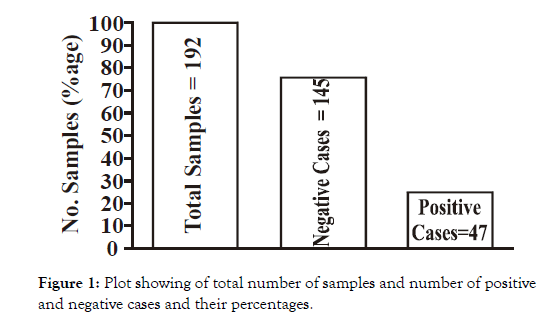
Figure 1: Plot showing of total number of samples and number of positive and negative cases and their percentages.
Gender wise result
Out of total 192 tests, 105 suspected males with high graded fever ranging between 100 to 105°F chills, vomiting, profuse sweating, anemia, muscle pain and shivering were examined, out of which 29 (27.61%) males were found positive and 76 were found negative for Plasmodium. Both ICT & thick and thin film methods were performed for the confirmation of positive stains. Positive tests were further confirmed by ICT device. While out of 192 samples, 87 female’s patients with high graded fever were examined, out of which 18 (20.68%) females were found positive and 69 were negative for Plasmodium (Figure 2).
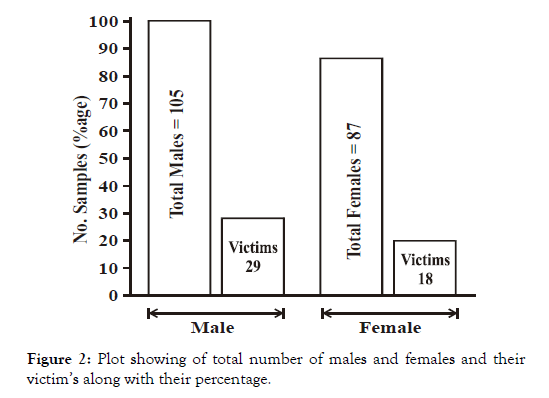
Figure 2: Plot showing of total number of males and females and their victim’s along with their percentage.
Gender wise result with reference to species
Out of 105 suspected male patients, 29 were found victims of Plasmodium infection. In 29 malarial patients, 15(51.72%) were infected by P. vivax; 12(41.37%) by P. falciparum, and 2(6.89%) by mixed species. While other 76 suspected patients were further consulted for diagnosis the disease. In a total of 87 suspected female patients, 18 were suffered from malaria. In 18 malarial patients, 10 (55.55%) were suffering from P. vivax and 8 (44.44%) by P. falciparum. Result is ordered in (Figure 3).
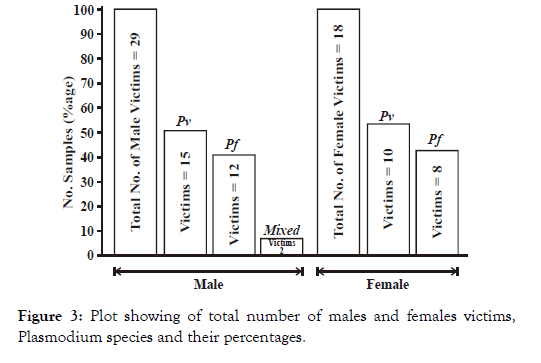
Figure 3: Plot showing of total number of males and females and their victim’s along with their percentage.
Species wise results
In species prevalence comparison, there were more victims of P. vivax i.e., 25 (53.19%), and a number of P. falciparum victims are 20 (42.55%) and the number of mixed species are 2 (4.25%). The result has shown in (Figure 4).
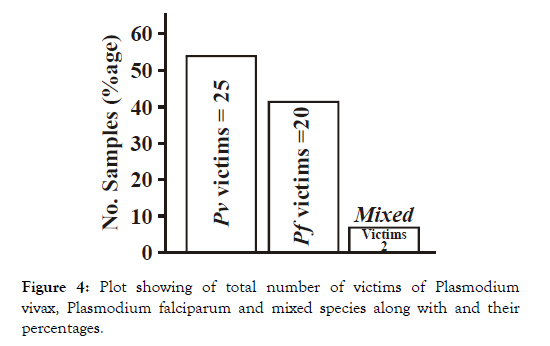
Figure 4: Plot showing of total number of victims of Plasmodium vivax, Plasmodium falciparum and mixed species along with and their percentages.
Age-wise results
The age-wise parameter indicated that the age range 21 to 30 years old are more victims consisting of 17 numbers (36.17%) followed by age range 31 to 40 years old consisting of 11 numbers (23.40 %) than the age group 11 to 20 years old with numbers 7 (14.89%). The age group 41 to 50 years old comprises of 5 people with percentage of 10.63 %, while both age groups 1 to 10 and 51 to 60 years old comprised of 3 numbers respectively having a percentage value of 6.38%. The lowest value was of age group 61-70 comprises of 1 number with percentage 2.12%. The data are also shown by (Figure 5).
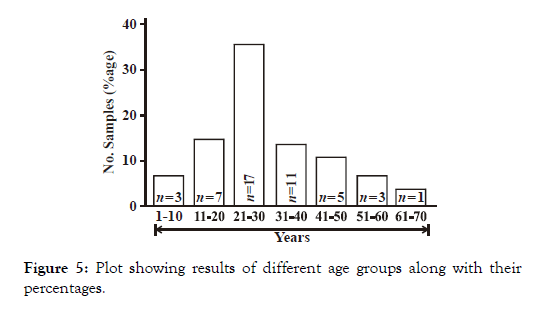
Figure 5: Plot showing results of different age groups along with their percentages.
Seasonal variations affect on Plasmodium infection distribution
The seasonal comparison revealed that there was a gradual rise in number of Plasmodium victims from March to August and then showed a reduction in severity in the month of September and October. In the month of March 11 blood samples were taken from the patient suffering from high graded fever. Out of these 11, one was found positive and identified as P. vivax. In the month of April, 12 blood tests were taken. Out of these 12, three were found positive in which two identified as P. vivax and one as P. falciparum. In the month of May, 19 blood tests were performed of which six were found positive, out of which 3 were identified as P. vivax and 3 as P. falciparum. In the month of June 37, blood samples were screened of which five were positive for P. vivax and three were for P. falciparum. In the month of July, 39 blood tests were examined. Out of these 39, ten were found positive; the number of P. vivax victims was five and for P. falciparum was also five, while in the month of August, the number of victims was high. A total of 52 blood samples were screened, out of which 15 samples were detected positive, in which seven were P. vivax, six were P. falciparum and two were mixed. In September, blood samples were collected from 16 people suffering from high graded fever. Out of these 16, 4 were identified as positive; two belonged to P. falciparum and two to P. vivax. Six tests were performed in October, but all were found negative for Plasmodium. Data is also ordered in tabular form in (Table 1).
Table 1: Seasonal variations effect on malaria distribution.
| Season | Month | No. of Sample | Pv | Pf | Mixed | Total |
|---|---|---|---|---|---|---|
| Spring with moderate temp | March | 11 | 1 | 0 | 0 | 1 |
| April | 12 | 2 | 1 | 0 | 3 | |
| May | 19 | 3 | 3 | 0 | 6 | |
| Summer with Extreme temp. & Monsoon | June | 37 | 5 | 3 | 0 | 8 |
| July | 39 | 5 | 5 | 0 | 10 | |
| August | 52 | 7 | 6 | 2 | 15 | |
| Hot & Post Monsoon Season | September | 16 | 2 | 2 | 0 | 4 |
| October | 6 | 0 | 0 | 0 | 0 | |
| Total | 192 | 25 | 20 | 2 | 47 |
Discussion
Plasmodium infection as health hazard in Pakistan
Pakistan is located in a tropical climate and a larger part of the populace is confined to agriculture and lives in a rustic region. The polluted and improper drainage system is a major source of malaria. ICTs are fast, simple to perform and decipher, save time and exertion, and contrast positively with other parasitological tests as a point-of-care detection strategy. In rural areas, still, microscopy method is used to diagnose malaria. The review of history revealed that Plasmodium infection (malaria) always remained the major cause of fatality and the severity and lead to death in the whole world. According to World Health Organization 2017 report, 219 million Plasmodium infected cases were reported all around the world, contrasted with 214 million cases in 2015 and 239 million cases reported in 2010 while 435000 deaths occurred in 2017 contrasted with 451000 deaths in 2016 and 607000 in 2010. This report also revealed that eighty-two percent of P. vivax victims residing in five countries, including Pakistan [12].
Comparison with previous research conducted in district Multan
The current research was completed in Multan district where the prevalence of Plasmodium infection is higher as compared to prior research conducted at Multan wherein out of 252 high graded fever patients were checked for either the prevalence of P. falciparum or and P. vivax. The result showed that the P. vivax had more prevalence with the result 8 (3.17%) as compared to P. falciparum with the result 3 (1.19%) [13]. While in this research, out of 192 high graded fever patients, 25 (13.02%) suffered from P. vivax; 20 (10.41%) suffered from P. falciparum and 2 (1.04%) suffered from mixed species. The result showed that P. vivax had more prevalence than P. falciparum and mixed species has existed in the region. The occurrence of P. species was similar to a past study conducted on the Thai-Myanmar border [14]. The higher rate of prevalence of Plasmodium types in this research would be because of an increase in population and pollution including stagnant water in this area.
Gender wise comparison
In gender-wise data, out of 105 males 29 (27.61 %) were more victims of Plasmodium infection than 18 females out of 87 (20.68%). The high number of males as compared to females in this research can be satisfied with the way that males are easily victims of Plasmodium infection on account of their work nature as they work in the fields, garden, filthy places, tyre shops, and marshy areas etc. A previous examination in Quetta, Pakistan also showed the large number of males as compared to females with high graded fever [15]. The results of this study also agreeing with another examination in Larkana district of Sindh, Pakistan, which also demonstrated the higher number of Plasmodium infections in males than females [6].
Gender wise comparison with reference to species
In gender wise comparison with respect to species, P. vivax had more prevalent in males 15 (51.72 %) as well as in females 10 (55.55%) as compared to P. falciparum with a number of 12 in males (41.37%) and 8 in females (44.44%). Past examinations taken in district Mansehra and Abbottabad of Province KPK, Pakistan showed a greater number of P. vivax infection than P. falciparum [16]. P. vivax is largely spread in moderate climates and had more commonality as compared to P. falciparum. It is observed that P. vivax is more capable to develop gametocytemia when the temperature is moderate [17]. Moreover, global environmental changes might be the strongest source of the epidemiology of P. vivax in this region [18]. Past observations indicated that mixed infections of P. vivax and P. falciparum also occurred [19-21]. It is concluded that P. malariae and P. ovale were not found in this research.
Age-wise comparison
Age-wise comparison revealed that, all the ages were victims of Plasmodium infection, but the age range 21 to 30 years old was more victims of Plasmodium infection (36.17%). These observations are comparable to the prior research with the percentage of (30.47%) of the age group of 21 to 30 years [22]. We can say that the age group comprises of 21 to 30 years is the age of art and work. On the account of their working activities they have more chances to bite by mosquitoes as they work and stay outside.
Seasonal comparison
Here we observed a gradual rise in Plasmodium infection from the month of March to August. The highest number observed in August 15 (31.91%) while least number was noted during the month of March 1 (2.12%). It is already reported that the gradual increase in temperature was favoring the development and multiplication of Plasmodium species [23].
In addition, we noted continuous rise in Plasmodium infection from March to August. The previous study also revealed that the steady rise in temperature and rainy season promoting the large reproduction of Plasmodium species in the month of July and August [19]. Hence, rise in temperature and rainy season in the month of July and August would be the major cause of Plasmodium infection in Multan district.
Conclusions
The prevalence of P. vivax was observed at a level that could be a great hazard to public health. The observations of this research will be useful to initiate a quick anti-malaria infection campaign to reduce and counteract the disease in the Multan district.
Future Work
In developing countries like Pakistan financial conditions, access to health care centers and social features varies among areas and populaces leading to the multiplicity of Plasmodium infection around there. The control and annihilation of Plasmodium infection request a functional methodology. Currently, we have a number of best quality devices as well as insecticide spraying and properly used bed nets that help to resist the transmission of the disease by means of the mosquito vector (Plasmodium). I realize we can overcome Plasmodium infection if all the countries take responsibility to eradicate this epidemic and help and support others to overcome this misery. This study will be very supportive in the future to initiate a prompt malaria control program to control this epidemic. This research also gives stress on early diagnosis and prompt treatment. This study also demands thorough and broad Public inculcation to increase public awareness about malaria, its treatments, control, and prevention.
Availability of Supporting Data
All data generated or analyzed during this study are included in this published article.
Funding
This research project was supported by the Virtual University of Pakistan and did not receive any specific grant from funding agencies in the public, commercial, or not-for-profit sectors.
REFERENCES
- World Health Organization. World malaria report 2015. World Health Organization. 2016.
- World Health Organization. World Malaria Report 2018. Geneva, Switzerland. 2018
- Cox FE. History of the discovery of the malaria parasites and their vectors. Parasite Vectors. 2010;3:1-9.
- Celli-Fraentzel A, Angelo C. The history of malaria in the roman campagna from ancient times. Roman Campagna from Ancient Times. 1933;1st Ed:1-214.
- Gachelin G, Garner P, Ferroni E, Tröhler U, Chalmers I. Evaluating cinchona bark and quinine for treating and preventing malaria. J Royal Soc Med. 2017;110:31-40.
- Soomro FR, Pathan GM, Gurbakhshani AL, Kakar JK. Prevalence of malarial parasites in Larkano district, Sindh, Pakistan. Gomal J Med Sci. 2010;8:1-9.
- Patz JA, Hulme M, Rosenzweig C, Mitchell TD, Goldberg RA, Githeko AK, et al. Climate change: Regional warming and malaria resurgence. Nature. 2002;420:620-628.
- Snow RW, Guerra CA, Noor AM, Myint HY, Hay SI. The global distribution of clinical episodes of Plasmodium falciparum malaria. Nature. 2005;434:214-217.
- Bouma MJ, Dye C, Vander-Kaay HJ. Falciparum malaria and climate change in the northwest frontier province of Pakistan. Am J Trop Med Hyg. 1996;55:131-137.
- Ghanchi NK, Shakoor S, Thaver AM, Khan MS, Janjua A, Beg MA. Current situation and challenges in implementing malaria control strategies in Pakistan. Crit Rev Microbiol. 2016;42:588-593.
- Nyunt MH, Kyaw MP, Win KK, Myint KM, Nyunt KM. Field evaluation of HRP2 and pan pLDH-based immunochromatographic assay in therapeutic monitoring of uncomplicated Falciparum malaria in Myanmar. Malaria J. 2013;12:119-123.
- Hartmeyer GN, Stensvold CR, Fabricius T, Marmolin ES, Hoegh SV, Nielsen HV, Kemp M, Vestergaard LS. Plasmodium cynomolgi as cause of malaria in tourist to Southeast Asia, 2018. Emerg Infect Dis. 2019;25:19-36.
- Tasawer Z, Mannan F, Arif BA. Prevalence of human malaria at Multan. Pak J Med Sci. 2003;3:123-126.
- Douglas NM, Nosten F, Ashley EA, Phaiphun L, Van-Vugt M, Singhasivanon P, et al. Plasmodium vivax recurrence following Falciparum and mixed species malaria: Risk factors and effect of antimalarial kinetics. Clin Infect Dis. 2011;52:612-620.
- Tareen AM, Rafique M, Wadood A, Qasim M, Rahman H, Shah SH, et al. Malaria burden in human population of Quetta, Pakistan. Euro J Microbiol Immunol. 2012;2:201-204.
- Soomro FR, Pathan GM, Gurbakhshani AL, Kakar JK. Prevalence of malarial parasites in Larkano district, Sindh, Pakistan. Gomal J Med Sci. 2010;8:1-9.
- Patz JA, Olson SH. Climate change and health: Global to local influences on disease risk. Ann Trop Med Parasitol. 2006;100:535-549.
- Strickland GT, Zafar-Latif A, Fox E, Khaliq AA, Chowdhry MA. Endemic malaria in four villages of the Pakistani province of Punjab. Transact Royal Soc Trop Med Hyg. 1987;81:36-41.
- Reiter P. The standardised freight container: Vector of vectors and vector-borne diseases. International Office of Epizootics. 2010;29:57-64.
- McKenzie FE, Bossert WH. Mixed-species Plasmodium infections of humans. J Parasitol. 1997;83:587-593.
- McKenzie FE, Bossert WH. Multispecies Plasmodium infections of humans. J Parasitol. 1999;85:1-12.
- Tareen AM, Rafique M, Wadood A, Qasim M, Rahman H, Shah SH, et al. Malaria burden in human population of Quetta, Pakistan. Euro J Microbiol Immunol. 2012;2:201-204.
- Beck-Johnson LM, Nelson WA, Paaijmans KP, Read AF, Thomas MB, Bjornstad ON. The effect of temperature on anopheles mosquito population dynamics and the potential for malaria transmission. PLOS One. 2013;8:e79276.
Citation: Bukhari SLS, Aslam K, Mansoor Z, Shabir G, Tayyab M, et al. (2021) Prevalence of Plasmodium Infection in District Multan, Punjab, Pakistan. J Trop Dis 9:271.
Copyright: © 2021 Bukhari SLS, et al. This is an open-access article distributed under the terms of the Creative Commons Attribution License, which permits unrestricted use, distribution, and reproduction in any medium, provided the original author and source are credited.

